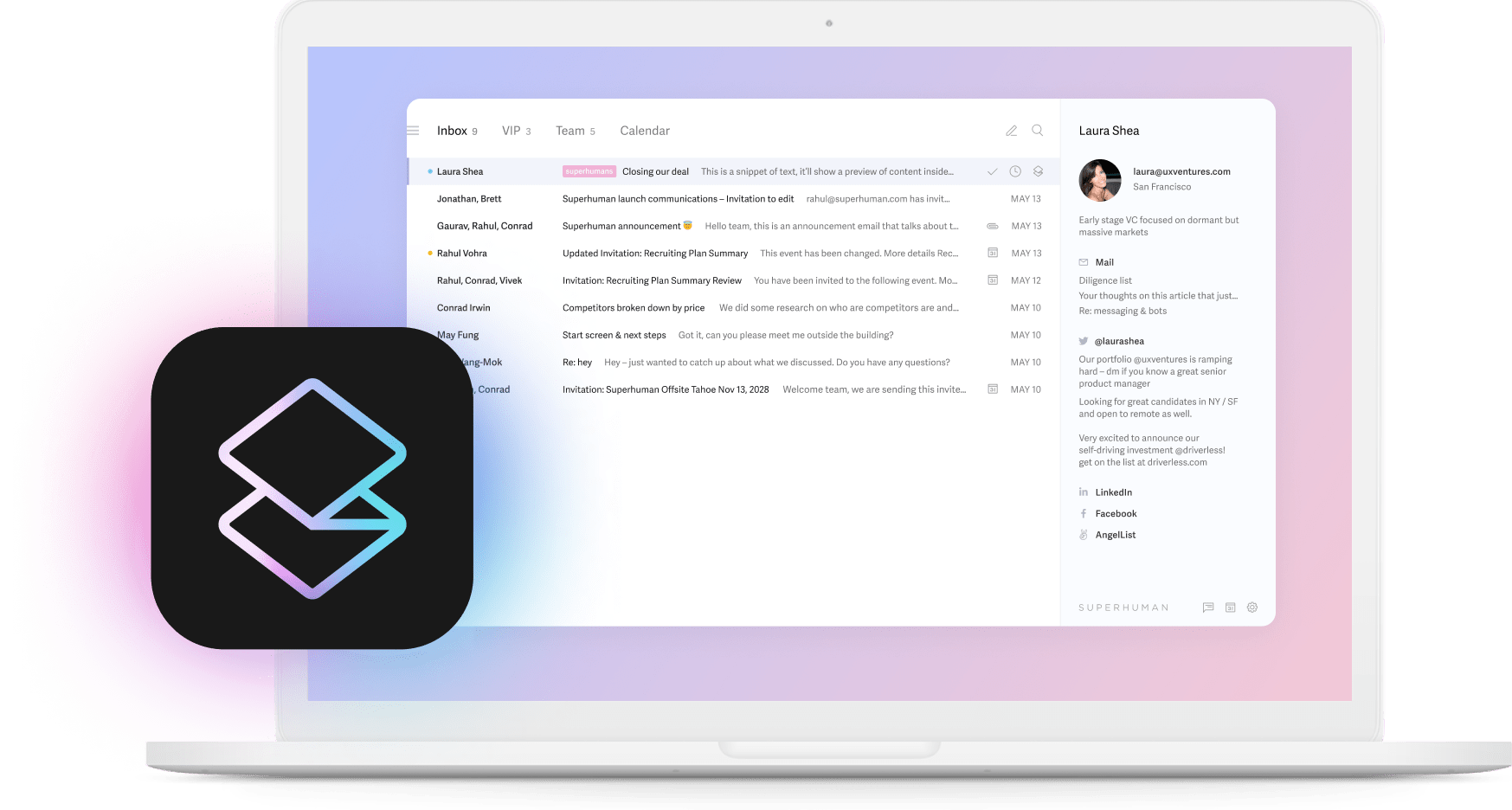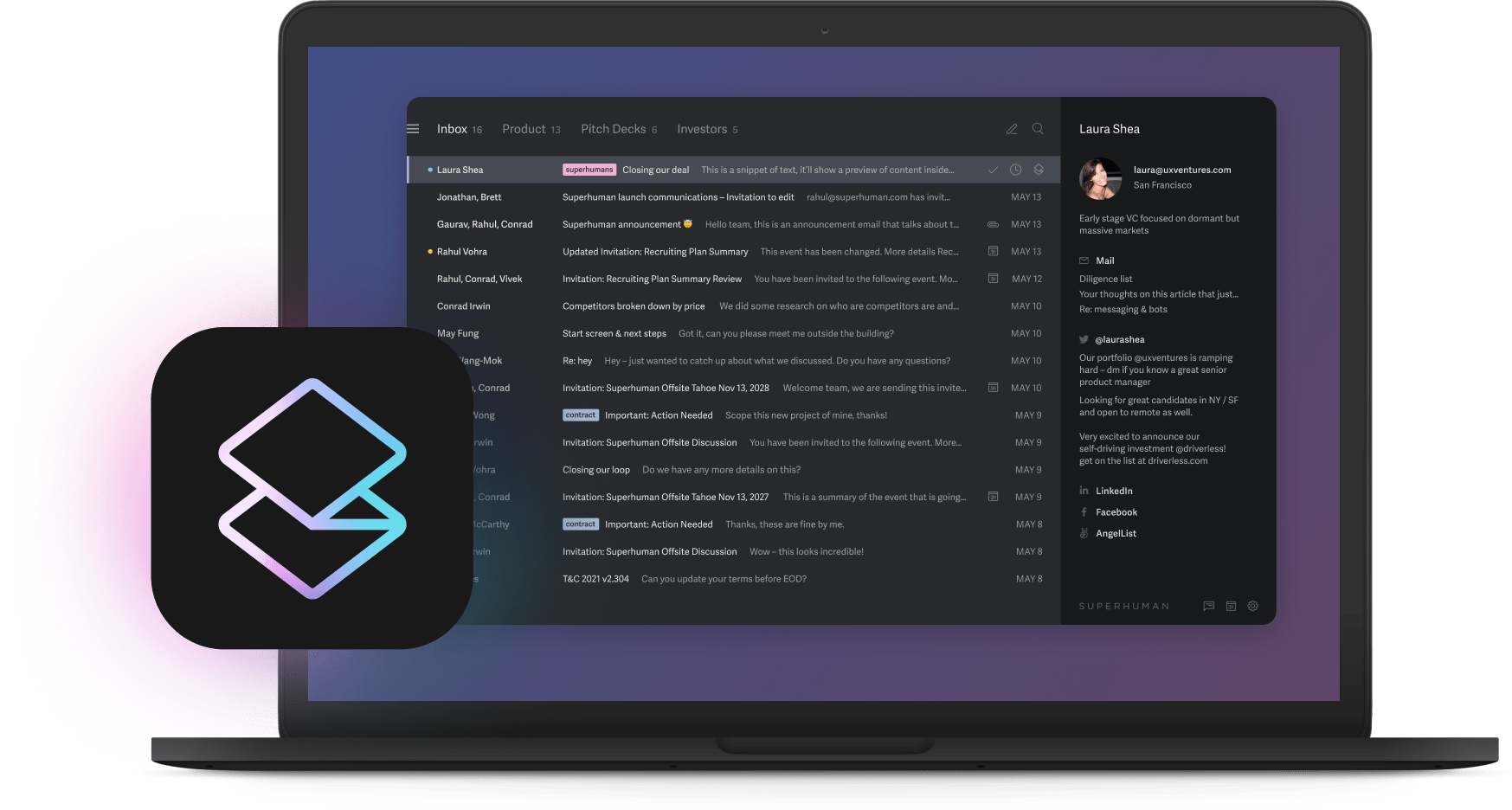
You know that feeling when you're drowning in emails from ten different stakeholders, each asking for updates on projects you already discussed in three other meetings? Meanwhile, you're manually copying data between spreadsheets for the weekly report nobody reads, and you still haven't written that product spec that's been "almost done" for two weeks.
We've all been there. The weird thing is, most of these problems could disappear with the right AI tools. Not the flashy ones everyone talks about, but the boring ones that handle the stuff eating up your day.
Here are eight of the best AI tools for product managers. We're not talking about productivity theater or shiny features that look good in demos. These tools eliminate specific frustrations that make product management harder than it needs to be.
1. Superhuman brings inbox order
Your inbox controls your schedule instead of the other way around. Important messages get buried under newsletter subscriptions you forgot about. You spend five minutes crafting a response that should take thirty seconds. Context switching between email and everything else destroys your momentum.
Superhuman fixes email by making it work the way you'd expect it to. The AI learns how you write to specific people and matches that tone without you teaching it. You write emails naturally, and it gets better at sounding like you over time.
Try SuperhumanSplit Inbox puts urgent stuff at the top automatically. Messages from your CEO, customer escalations, and notifications from tools like Asana all get priority placement. You see what matters first instead of hunting through everything.
When you need to reply, Instant Reply suggests responses that actually sound like you wrote them. Snippets let you insert common responses with a few keystrokes. Your whole team can share the best templates so everyone sounds consistent.
Shared Conversations let your team discuss emails internally without forwarding chains or copying people unnecessarily. Read Statuses show exactly when someone opened your message and what device they used. No more wondering if your urgent email disappeared into the void.
Social Insights pull up details about who you're emailing, so every interaction feels more personal and strategic.
Start here: Turn on Split Inbox first. You'll immediately see your most important emails without digging through the noise.
Superhuman saves you 4 hours every week, and you respond 12 hours faster and handle twice as many emails. Your inbox feels 10x lighter because the workflow actually makes sense.
Try Superhuman2. ChatGPT thinks differently than you do
You stare at a blank document for twenty minutes. You need fresh ideas, but keep circling back to the same approaches. Stakeholders want detailed plans by tomorrow, and you're starting from scratch. You're writing the same types of documents repeatedly, and it's draining your creativity.
ChatGPT becomes the brainstorming partner who never gets tired or runs out of ideas. It thinks through problems from angles you wouldn't consider, which breaks you out of mental ruts. Plus, it adapts to however you want to communicate, whether you're writing to engineers or executives.
Try these prompts that work:
- "Create a prioritization matrix for these 5 feature requests based on impact versus effort."
- "Draft OKRs for Q2 focusing on user retention with measurable success criteria"
- "Generate a feature brief template for mobile improvements targeting busy professionals."
The AI approaches problems differently than humans do. That's the point. It can write in any tone you need, from casual team updates to formal executive summaries.
But watch out for generic outputs when your prompts lack detail. Never paste sensitive product information since conversations aren't private.
3. ChatPRD eliminates spec writing drudgery
You spend entire afternoons writing product requirement documents that follow the same basic structure every time. Getting stakeholder input takes forever. Version control becomes a chore when multiple people edit the same document.
ChatPRD turns spec writing from an afternoon-long project into a ten-minute task. Pick a template that matches your situation, answer a few questions, and get a complete document that makes sense.
The template library covers most scenarios you'll face: new feature launches, API specifications, user story collections, and competitive analysis frameworks. Each template comes from real product teams who've refined them through multiple projects.
Team collaboration features let everyone contribute without stepping on each other's toes. Version history shows exactly what changed and when. Enterprise security keeps sensitive details locked down while enabling the collaboration you actually need.
The platform focuses specifically on PRDs, which means you might need other tools like Notion or Confluence for broader documentation needs.
4. Mixpanel shows what's actually happening
You wait days for the data team analysis that should take minutes. Building conversion funnels requires technical knowledge you don't have. A/B test results come too late to influence decisions that matter.
Mixpanel gives you instant answers about how people use your product. The AI builds conversion funnels automatically, spots unusual patterns, and runs experiments without requiring data science expertise.
When you launch a new feature, the platform tracks user behavior immediately and shows exactly where people drop off. AI recommendations suggest specific improvements based on what it observes. Real-time experiment results let you make decisions while they still matter.
You get actionable insights without waiting for someone else's availability. Built-in testing tools mean you can validate ideas quickly and iterate based on real data instead of opinions.
5. Productboard connects feedback to roadmaps
Customer feedback sits scattered across support tickets, sales calls, and research notes. Finding patterns requires manual analysis that takes forever. Stakeholders constantly ask why certain features were prioritized over others.
Productboard connects feedback directly to your roadmap through a process that actually works.
- First, it pulls in feedback from everywhere: support systems, sales tools, customer interviews, and user research sessions. Everything goes into one place instead of living in separate systems that don't talk to each other.
- Second, AI clusters related feedback and analyzes sentiment across all sources. You see themes emerge without manually reading hundreds of comments. Similar requests get grouped together automatically.
- Third, it generates roadmap items with priority scores based on customer impact and business value. Stakeholders can see exactly why features ranked where they did instead of guessing at your logic.
Customer-facing roadmap views let you share plans without revealing internal details. Impact scoring helps everyone understand prioritization decisions.
6. ClickUp handles everything in one place
You switch between project management, documentation, and communication tools constantly. Creating templates for common tasks takes longer than doing the work manually. Team members use different tools for similar functions, which creates chaos.
ClickUp combines project management, documentation, and AI assistance in a single workspace. The AI writing assistant generates templates for user stories, stakeholder updates, competitive analysis, and other routine documents.
Sprint planning, customer survey creation, and retrospective facilitation all happen in the same place. No more context switching between separate tools for related tasks.
The comprehensive approach reduces tool sprawl for lean teams while providing AI-powered content creation for routine documentation work.
7. Tl;dv captures decisions automatically
Important decisions get made in meetings, but are lost in follow-up messages. Engineering teams need specific clips from discussions, not entire meeting recordings. Searching through hours of video for one decision wastes everyone's time.
Tl;dv records meetings and lets you tag important moments as they happen. Share specific clips with people who need that information instead of forcing them to watch everything.
The platform automatically transcribes conversations and makes them searchable. When someone asks, "What did we decide about the API changes three weeks ago?" you can find the exact moment instead of guessing or scheduling another meeting to re-discuss it.
Highlight reels summarize key discussions for stakeholders who couldn't attend. Engineering handoffs become precise: tag technical decisions during meetings, then share specific clips with developers who need to implement them.
Audio quality affects transcription accuracy, so invest in decent microphones.
8. Kadoa automates data drudgery
You spend hours compiling reports that follow the same format every week. Usage logs need manual analysis that delays important decisions. Data lives in different systems that don't talk to each other.
Kadoa creates automated data pipelines without requiring engineering help. The platform pulls information from multiple sources, processes it according to rules you set, and populates dashboards automatically.
Weekly executive reports that used to take half a day now generate themselves. User behavior data flows from analytics tools into decision-making dashboards without manual intervention.
No-code pipeline creation makes data automation accessible to non-technical product leaders. You can automate routine reporting and analysis without waiting for engineering resources or learning to code.
Functionality depends on supported data sources and formats. Evaluate your specific workflow requirements against platform capabilities before committing.
Start with your biggest frustration
Pick one tool that solves your biggest daily frustration. Don't try to implement everything at once. That's how you end up with more problems than you started with.
Most teams benefit from fixing email overload and communication bottlenecks first, since those problems amplify everything else. After that, tackle documentation or analytics depending on where you spend the most unproductive time.
Measure success by tracking time saved on routine tasks, faster decision-making, and team satisfaction scores. Most teams see meaningful results within 2-4 weeks when they focus on one specific problem instead of trying to optimize everything simultaneously.
Choose the tool that addresses your biggest time sink and pilot it this week. Success comes from solving specific workflow problems, not general productivity improvements that sound good in theory but don't change how you work.






